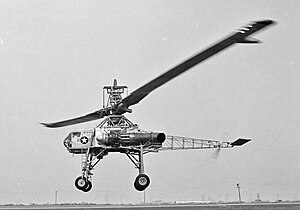

This article includes a list of references, related reading, or external links, but its sources remain unclear because it lacks inline citations. Please help improve this article by introducing more precise citations. (July 2014) (Learn how and when to remove this message)
|
| XH-17 "Flying Crane" | |
|---|---|

| |
| Role | Helicopter
Type of aircraft
|
| Manufacturer | Hughes Helicopters |
| First flight | 23 October 1952 |
| Retired | December 1955 |
| Status | Scrapped |
| Number built | 1 |
The Hughes XH-17 "Flying Crane" was the first helicopter project for the helicopter divisionofHughes Aircraft Company. The XH-17, which had a two-bladed main rotor system with a diameter of 134 feet (41 m), still holds the world record for flying with the largest rotor system. It was capable of flying at a gross weight of more than 50,000 pounds (23,000 kg), but proved too inefficient and cumbersome to be mass-produced beyond the prototype unit.
The XH-17 was a heavy-lift rotorcraft that was designed to lift loads in excess of 15 metric tons. To speed construction, parts of the XH-17 were scavenged from other aircraft. The front wheels came from a North American B-25 Mitchell and the rear wheels from a Douglas C-54 Skymaster. The fuel tank was a bomb bay-mounted unit from a Boeing B-29 Superfortress. The cockpit was from a Waco CG-15 military glider and the tail rotor from a Sikorsky H-19 Chickasaw was used for yaw control.
In the late 1940s, Hughes developed an interest in helicopters. In August 1947, helicopter manufacturer Kellett sold his design for the giant XH-17 Sky Crane to Hughes, who commissioned the development of the XH-17 Flying Crane research vehicle. In 1948, the XH-17 began to take shape. The giant helicopter was tested in Culver City, California over a three-year period beginning in 1952. The XH-17 flew in 1953 at a gross weight in excess of 50,000 pounds (23,000 kg). It still holds the record for flying with the world's largest rotor system. Only one unit was built, since the aircraft was too cumbersome and inefficient to warrant further development.
The propulsion system was unusual. Two General Electric J35 turbojet engines were used, sending bleed air up through the rotor hub. The blades were hollow, and the hot compressed air traveled through the blades to tip jets where fuel was injected. In flight, the main rotor spun at a sedate 88 revolutions per minute, less than half the speed of typical helicopter rotors. Since the rotor was driven at the tips rather than the hub, little torque compensation was required, mostly due to friction in the main rotor bearing. Thus, the XH-17 had a very small tail rotor compared to its main rotor. This drive system was inefficient, limiting the test aircraft to a range of only 40 miles (64 km).
The XH-28 was a derivative, with a maximum weight of 104,000 pounds (47,000 kg). Though a wooden mockup of the design was made, the program was canceled and none were built.


Data from McDonnell Douglas aircraft since 1920 Vol.2[1]
General characteristics
Performance
Aircraft of comparable role, configuration, and era
|
| |
|---|---|
| Fixed-wing aircraft |
|
| Experimental helicopters |
|
| Civil helicopters |
|
| Military helicopters |
|
| Communications satellites |
|
| Spacecraft |
|
| Avionics /Fire control |
|
| Missiles |
|
|
United States helicopter designations, Army/Air Force and Tri-Service systems
| |||||||||
|---|---|---|---|---|---|---|---|---|---|
Numerical sequence used by USAAC/USAAF/USAF 1941–present; U.S. Army 1948–1956 and 1962–present; U.S. Navy 1962–present | |||||||||
| Army/Air Force sequence (1941–1962) |
| ||||||||
| Tri-service sequence (1962–present) |
| ||||||||
1 Not assigned | |||||||||